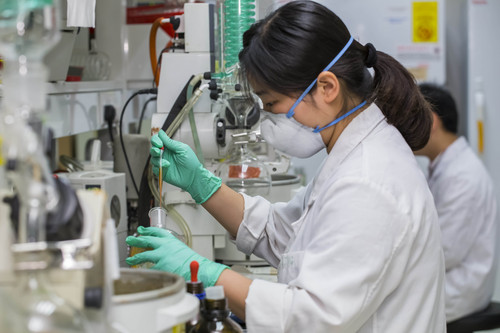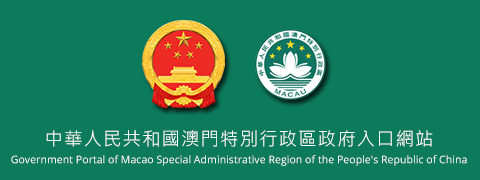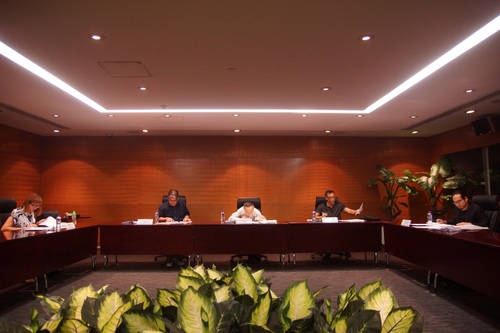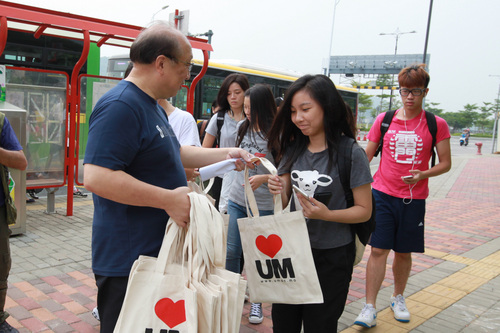Macao SAR Government Portal
News
Visitor arrivals for July 2015
Information from the Statistics and Census Service (DSEC) indicated that visitor arrivals totalled 2,648,894 in July 2015, up by 17.8% month-to-month but down by 3.8% year-on-year. Same-day visitors decreased by 6.4% year-on-year to 1,353,271 (51.1% of total); overnight visitors dropped marginally by 0.9% to 1,295,623. The average length of stay of visitors increased by 0.2 day year-on-year to 1.2 days; overnight and same-day visitors had an average stay of 2.2 days and 0.2 day respectively. Visitors from Mainland China decreased by 6.1% year-on-year to 1,757,167, with those travelling under the Individual Visit Scheme dropping by 5.3%, at 824,536. Mainland visitors came primarily from Guangdong Province (785,152), Fujian Province (82,043) and Hunan Province (74,193). Visitors from the Republic of Korea (37,050) decreased by 22.5% year-on-year, while those from Hong Kong (586,136) and Taiwan (93,443) increased by 5.7% and 0.1% respectively. Long-haul visitors from the United States (15,579), Australia (6,674), Canada (5,237) and the United Kingdom (4,919) registered year-on-year decline. Regarding mode of transport, visitor arrivals by land totalled 1,496,405, up slightly by 0.9% year-on-year; visitors entering through the Border Gate (1,311,556) decreased by 1.3% to account for 87.6% of the total, while those arriving via the Checkpoint of Cotai (182,786) rose by 20.5%. Visitor arrivals by sea dropped by 10.6% year-on-year to 975,577, with those entering via the Outer Harbour (588,804) and the Provisional Ferry Terminal in Taipa (361,709) dropping by 11.5% and 7.5%. Visitor arrivals by air decreased by 1.1% year-on-year to 176,912, with those entering via the airport (175,848) edging down by 0.3%. In the first seven months of 2015, visitor arrivals totalled 17,405,393, down by 3.5% year-on-year; same-day visitors (9,493,413) and overnight visitors (7,911,980) decreased by 1.5% and 5.7% respectively. Visitors from Mainland China (11,541,959) decreased by 4.5% year-on-year, while those from Taiwan (558,940) held stable. Visitors from Hong Kong (3,741,288) and the Republic of Korea (330,613) increased by 0.6% and 4.8% respectively. Moreover, long-haul visitors from the United States, Australia, Canada and the United Kingdom recorded year-on-year decrease.
…
MGTO organizes a media release workshop for hotel industry
Macau Government Tourist Office (MGTO) held a workshop named “Upgrading Media Releases in the Internet Era” for hotel industry personnel and MGTO staff on 25 and 26 August to enhance their knowledge and skills in media communication. The Tourist Office has invited Executive Editor of Travel Impact Newswire, Imtiaz Muqbil to give a talk in the workshop about changes in the global and regional world order, revolution in the tourism industry as well as useful skills about media release. Imtiaz Muqbil has been a professional journalist since 1973 and reported on the Asia-Pacific travel industry since 1981. He founded Travel Impact Newswire in 1998, a publication which covers Asia-Pacific tourism with an analytical, long-term perspective for a wide range of readers across the world, many of whom are decision makers in the travel industry. Its readership covers different continents, regions and nationalities such as Europe, North America, the Middle East, India, China and many other Southeast Asian countries. Muqbil is also the winner of the 2005 PATA Travel Journalism Award. Founded in 1951, the Pacific Asia Travel Association (PATA) is a non-profit membership association dedicated to promoting sustainable development of the Asia-Pacific travel industry. MGTO regularly partners with the trade and training entities to create a variety of training opportunities for travel agents, tour guides and personnel of the hotel, retail and catering industries as well as public transportation sector. The Office will keep on helping the tourism and related sectors to upgrade their service quality in accord with the goal of building Macau into a World Centre of Tourism and Leisure.
…
Results of retail sales survey for the 2nd quarter 2015
Information from the Statistics and Census Service (DSEC) indicated that value of retail sales for the second quarter of 2015 amounted to MOP 14.26 billion, down by 12% compared with the revised figure of MOP 16.28 billion in the first quarter. Retail sales of Watches, Clocks & Jewellery (MOP 2.98 billion) accounted for 21% of the total, which was followed by retail sales of Goods in Department Stores (14%), Adults' Clothing (10%), Leather Goods (10%), Goods in Supermarkets (8%) and Motor Vehicles (6%). In comparison with the second quarter of 2014, value of retail sales for the second quarter of 2015 decreased by 13%, with marked decrease being observed in sales of Watches, Clocks & Jewellery (-29%), Motor Vehicles (-29%), Leather Goods (-22%), Adults' Clothing (-16%) and Goods in Department Stores (-15%). On the other hand, sales of Communication Equipment (+37%) and Cosmetics & Sanitary Articles (+20%) showed notable increase. Value of retail sales for the first half year of 2015 totalled MOP 30.54 billion, down by 12% year-on-year. After removing the effect of price changes, volume of retail sales for the second quarter of 2015 decreased by 13% quarter-to-quarter, with marked decrease in sales of Footwear (-25%), Adults' Clothing (-25%), Watches, Clocks & Jewellery (-20%), Communication Equipment (-14%), Goods in Department Stores (-12%) and Motor Vehicles (-11%). Meanwhile, volume of retail sales for the second quarter decreased by 10% year-on-year, of which sales of Motor Vehicles (-28%), Watches, Clocks & Jewellery (-25%), Leather Goods (-19%), Adults' Clothing (-17%) and Goods in Department Stores (-17%) recorded notable decline; however, sales of Communication Equipment and Cosmetics & Sanitary Articles surged by 39% and 20% respectively. Volume of retail sales for the first half year of 2015 decreased by 10% year-on-year. In respect of the comments of the retailers, about 67% stated that sales volume in the second quarter of 2015 decreased over the previous quarter, up by 8 percentage points compared with the corresponding figure in the first quarter of 2015, while 33% reported increased or stable sales volume. In terms of the retail prices, about 58% reported stable prices, 33% noted a decrease and 9% stated an increase. Moreover, about 58% of the retailers expressed that the stock level remained stable compared with the second quarter of 2014, while 21% indicated that the stock level decreased. As regards business outlook for the third quarter of 2015, about 46% of the retailers anticipate that sales volume will decrease from the second quarter, 37% expect sales volume to remain stable, while 17% expect an increase. Concurrently, about 67% predict stable retail prices, 28% expect a decrease, while 5% predict an increase in retail prices.
…
Results of visitor expenditure survey for the 2nd quarter 2015
Information from the Statistics and Census Service (DSEC) indicated that total spending (excluding gaming expenses) of visitors in the second quarter of 2015 amounted to MOP12.25 billion, representing a decrease of 24.7% from MOP16.26 billion in the second quarter of 2014, and an 8.3% decline from MOP13.36 billion in the first quarter of 2015. Spending of overnight visitors totalled MOP9.58 billion, down by 30.4% year-on-year, while that of same-day visitors increased by 7.3% to MOP2.67 billion. In the second quarter of 2015, per-capita spending of visitors was MOP1,668, down by 22.1% year-on-year and 7.4% quarter-to-quarter. Per-capita spending of visitors from Mainland China fell by 24.3% year-on-year to MOP2,012; those from Guangdong Province and Fujian Province spent an average of MOP1,657 (+8.4%) and MOP2,266 (-17.0%). Per-capita spending of Mainland visitors travelling under the Individual Visit Scheme (IVS) dropped by 14.9% year-on-year to MOP2,530, with those from Guangdong Province and Fujian Province spending an average of MOP1,891 (+13.0%) and MOP3,728 (-19.8%) respectively. Moreover, per-capita spending of visitors from Singapore (MOP1,741), Japan (MOP1,543) and Malaysia (MOP1,506) decreased by 6.7%, 23.9% and 12.0% respectively year-on-year; spending of those from Taiwan (MOP1,374) and Hong Kong (MOP870) also registered decline. Visitors from Australia had relatively high per-capita spending among the long-haul visitors, at MOP1,523, yet decreased by 5.4% year-on-year, while spending of those from the United Kingdom (MOP1,212) increased by 3.5%. Per-capita spending of overnight visitors fell by 28.0% year-on-year to MOP2,820, while that of same-day visitors increased by 10.8%, at MOP676. Overnight visitors from Mainland China (MOP3,455), Taiwan (MOP2,888) and Singapore (MOP2,796) had relatively high per-capita spending, though year-on-year decreases were recorded. Among the same-day visitors, per-capita spending of Mainland visitors topped at MOP838, up by 14.5% year-on-year, and that of IVS visitors was MOP1,392, up by 15.1%. Analysed by consumption structure, visitors spent mainly on Shopping (45.1%), Accommodation (24.9%) and Food & Beverage (21.7%). Per-capita shopping spending dropped by 28.4% year-on-year to MOP751, and the preferred shopping items included Local Food Products (28.4%) and Cosmetics & Perfume (21.9%). Visitors from Mainland China spent an average of MOP1,064 on shopping, and shopping spending of IVS visitors was MOP1,599. Meanwhile, long-haul visitors spent primarily on Accommodation and Food & Beverage. According to the results of Visitors’ Comments Survey in the second quarter of 2015, about 89.0% of the visitor-users were satisfied with the services and facilities of hotels, up slightly by 0.4 percentage points quarter-to-quarter; those who complimented about the services of gaming establishments (85.8%), retail shops (83.6%) and travel agencies (83.3%) rose by 2.5, 0.5 and 0.7 percentage points respectively. About 82.3% of the visitors commented that the environmental hygiene was satisfactory, up by 3.5 percentage points. Meanwhile, 41.2% of the visitors commented that points of tourist attractions were adequate, up modestly by 0.2 percentage points quarter-to-quarter. Moreover, 12.6% of the visitors considered that public transport services should be improved, down by 0.8 percentage points, but those complimented about the services (74.3%) also decreased by 0.5 percentage points.
…
Consumer price index (CPI) for July 2015
Information from the Statistics and Census Service (DSEC) indicated that the Composite CPI for July 2015 increased by 4.76% year-on-year to 106.13, down from the 4.91% growth in June 2015. The increase was attributable to higher rentals for dwellings and rising charges for eating out. In comparison with July 2014, notable increase was observed in the price index of Alcoholic Beverages & Tobacco (+28.11%); Housing & Fuels (+8.72%) and Health (+5.98%) on account of an increase in tobacco tax, as well as rising rentals for dwellings and higher charges for out-patient services. On the contrary, price index of Communication decreased by 0.76%. The CPI-A (106.34) and CPI-B (104.40) increased by 5.21% and 3.71% respectively year-on-year. The Composite CPI for July 2015 increased by 0.22% month-to-month. Higher prices of tobacco pushed up the price index of Alcoholic Beverages & Tobacco by 32.00%, while rising charges for package tours caused the price index of Recreation & Culture to rise by 1.49%; meanwhile, lower prices of gasoline tapered off the increase in the price index of Housing & Fuels. On the other hand, price index of Clothing & Footwear decreased by 3.35% owing to seasonal sale of summer clothing; moreover, price index of Transport decreased by 0.48% upon receding prices of gasoline. The CPI-A increased by 0.25% month-to-month while the CPI-B edged down by 0.03%. For the 12 months ended July 2015, the average Composite CPI increased by 5.33% from the previous period. Price index of Housing & Fuels (+10.86%); Food & Non-Alcoholic Beverages (+5.43%) and Health (+5.28%) showed marked increase. The average CPI-A and CPI-B rose by 5.80% and 4.75% respectively. The average Composite CPI for the first seven months of 2015 increased by 4.89% year-on-year, with the price index of Housing & Fuels; Health and Food & Non-Alcoholic Beverages rising by 10.07%, 5.72% and 5.11% respectively. The average CPI-A and CPI-B rose by 5.33% and 4.07% respectively. The Composite CPI reflects the impact of price changes on the general households. The CPI-A relates to about 50% of the households, which have an average monthly expenditure of MOP10,000 to MOP29,999. The CPI-B relates to about 30% of the households, which have an average monthly expenditure of MOP30,000 to MOP54,999.
…
UM’s 10 research projects receive NSFC grants
 UM’s various research projects receive funding from the National Natural Science Foundation of China
UM’s various research projects receive funding from the National Natural Science Foundation of China
The University of Macau’s (UM) Zhuhai Research Institute (UMZRI) will receive a total of RMB 4 million in funding from the National Natural Science Foundation of China (NSFC) for ten research projects, according to the results of grants application for the year 2015 recently released by the NSFC. This year, UM submitted funding applications to the NSFC for 38 research projects. It is encouraging news that over 26% of them, or ten applications, have been approved. The ten funded research projects are respectively headed by Faculty of Science and Technology (FST) Chair Professor Philip Chen; FST professors Li Yangmin and Zhu Lei; FST associate professors Zhou Wanhuan and Xu Qingsong; FST assistant professors Dr U Leong Hou and Dr Xu Lihu; as well as Institute of Chinese Medical Sciences (ICMS) assistant professors Dr Lu Jiahong, Dr Wan Jianbo, and Dr Wang Chunming. Five of the projects, namely ‘Ergodicity of Stochastic Partial Differential Equations Driven by Degenerate Jump Processes’, ‘Design and Control of Fully Compliant 3-DOF Constant-Force Micropositioning Stage for Cell Microinjection with Minimal Damage’, ‘Design Theory and Dynamic Hysteresis Nonlinear Control Method Studies for a 6-DOF Micro Manipulation Stage Based on Hybrid Giant Magnetostrictive and Piezoelectric Actuators’, ‘Wideband Antennas on Multi-Mode Radiator: Theory and Approach’, and ‘Evolutionary Computation Based Deep Learning Techniques for Disease Prevention and Control’, have been selected by the NSFC as some of this year’s General Programmes. Only projects that fulfill certain requirements with significance and research merits will qualify as General Programmes. The other five projects, namely ‘Shearing Behavior and Multiscale Constitutive Modeling of Silty Sand-Structure Interface’, ‘Reviewer Assignment Algorithm Design and Analysis’, ‘The Role and Mechanism of Beclin 1-VPS34 Complex in Regulating Intra-neuronal Aβ Homeostasis’, ‘An Injectable, in Situ-forming Glucomannan Biomaterial for Periodontal Tissue Regeneration’, and ‘Anti-atherosclerotic Effects of 20(S)-protopanaxatriol and 20(S)- protopanaxdiol Saponins from Panax Notoginseng’, stood out in the category which the NSFC has established specially for young scholars under the age of 35. Founded in 1986, the NSFC aims to encourage innovative scientific research and to promote balanced, coordinated, and sustainable development of various academic disciplines by awarding research grants to outstanding research projects in China on an annual basis.
…
Monetary Authority of Macao and People’s Bank of China entered into MOU on Prevention of Money Laundering and Terrorist Financing
In accordance with the recommendations advocated by the Financial Action Task Force (FATF) on cross border regulatory cooperation, the Monetary Authority of Macao (AMCM) and the People’s Bank of China (PBC) entered into the “Memorandum of Understanding on Prevention of Money Laundering and Terrorist Financing” (“MOU”). The AMCM and the PBC, in line with the relevant laws and regulations of the Macao SAR and the Mainland respectively, as well as the standards of the FATF, shall strengthen the exchange of regulatory information and the cooperation in the relevant aspects of supervision. The AMCM has been exerting efforts in enforcing the prevention of activities of money laundering and terrorist financing. The implementation of the MOU shall further enhance and strengthen the management of the prevailing supervisory system to prevent the activities of money laundering and terrorist financing in the financial sector of the Macao SAR.
…
Government to take all measures ensuring financial stability
The Government would take all measures necessary to maintain stability and smooth operation of the local financial system. The Government expected its investments of financial reserves would gain positive yearly returns despite the temporary loss in stock markets caused by the volatility of external markets recently. The market fluctuation, however, brought limited impact to local banking system, since there was more than 50 billion of floating capital in Macao as of 24 August, and the currency and interest rates market remained steady during the period. Moreover, the Government only invested 41.3 billion patacas into stock markets, which accounts to around 11.8 per cent of the overall investment portfolio. The Government would continue to closely monitor foreign markets and local banking system as to ensure the stability of the economy. Residents are urged to pay extra attention to risk management when investing in stock markets.
…
2015 Guangdong–Hong Kong–Macao Film Production Investment and Trade Fair Macao Film Project Selection Completed
The Macao film project selection for the 2015 Guangdong–Hong Kong–Macao Film Production Investment and Trade Fair (“The Fair”) was completed on 16th August with ten submissions selected. Ung Vai Meng, President of the Cultural Affairs Bureau, and members of the adjudicating panel invited by the Bureau attended the event. The applicants of the selected film projects will be invited to attend the Fair next month where they can meet with investors and producers from the three regions and have the opportunity for further discussion and co-operation. The Fair was co-organised by the Cultural Affairs Bureau, the Hong Kong Film Development Council, and the Guangdong Administration of Press, Publication, Radio, Film and Television since 2014. This year, Macao will host the Fair on 23rd and 24th September and provide a high-level and convenient communication platform for film investors and producers from the three regions. It not only helps to build a channel for film investment and co-operation, but also cultivates filmmaking talents and promotes the film industry in the three regions. Members of the adjudicating panel for this selection include Zheng Dawei, Secretary-general of the Guangdong Motion Picture Industry Association; Albert Chu Iao Ian, President of the Macau Association of Audio-Visual “CUT”; Chan Kin Tak, Macao film director; Rita Wong, film curator; and Chan Peng Fai, Acting Vice President of the Cultural Affairs Bureau. After the discussion by the panel, ten film applications are selected in the assessment procedure. The adjudicating panel selected the eligible film projects based on creativity of the story, experience and execution ability of the applicant and the executive producer and production team, as well as rationale of budgeting. After assessment, all ten applications were passed and will be invited to attend the Fair next month. The panel also provides their suggestions on the film proposals, expecting the eligible applicants will have a better performance at the Fair. Applicants of the selected film projects will receive notification from the Cultural Affairs Bureau in several days. The list will also be published on the Cultural Affairs Bureau website (www.icm.gov.mo) or the Macao Cultural and Creative Industries Website (www.macaucci.com). For enquiries about the results, please contact Mr. Chong or Mr. Leong from the Cultural Affairs Bureau, through tel. no. (853) 2892 4040 during office hours.
…
School starts today, UM campus runs smoothly
Today (24 August) is the first day of the new academic year at the University of Macau (UM). Everything is running smoothly on the campus. The first day of the new semester saw the influx of more than 500 faculty members and over 9,000 students, including 2,000 new undergraduate and postgraduate students. A student says he is very excited about starting his first day of classes at UM and he looks forward to a new way of learning. UM Rector Wei Zhao expressed thanks to all the colleagues for working hard during the summer holiday to prepare for the new academic year. He hopes UM teachers and students will work harder in the new semester to help UM make new academic progress. In the summer holiday, UM installed new facilities and made improvements to existing facilities, including teaching buildings, sports facilities, and residential buildings, in order to provide the best possible learning and living environment for students and faculty. The frequency of the campus shuttles has also been increased to meet the surging demand. Many students started to queue up for buses to the campus at the Praça de Ferreira do Amaral bus stop around 8:00am this morning. Rector Zhao and Dean of Students Peter Yu visited the bus stop and wished students luck on the first day of school. The Transport Bureau increased bus service frequency during rush hours to provide maximum convenience for UM students. UM also arranged for some shuttle buses to take students to the campus. Rector Zhao and college masters visited some classrooms and dining facilities in the residential colleges to check how students were doing on the first day of school. Rector Zhao also visited several student-run shops to show support. A fourth-year student from the Faculty of Business Administration (FBA), who is also the manager of one of the student-run shops, says: ‘The shop has been running smoothly so far. I would like to thank the university for giving us an opportunity to start our own business. We will do our best to serve the university community.’ Rector Zhao also visited recruitment booths of the Students’ Union and its sub-organisations in the Student Activity Centre to show support. ‘Public transport was very good this morning,’ says a freshman from the Faculty of Law. ‘I was surprised to see the rector greeting students at the bus stop.’ Another freshman from the FBA says: ‘The rector is very friendly and the arrangement for the first day is good. Earlier the university organised sit-in sessions to help students adapt to a new mode of learning.’ A second-year student from the Faculty of Science and Technology says: ‘I look forward to meeting new friends and professors and starting a new way of learning.’
…




